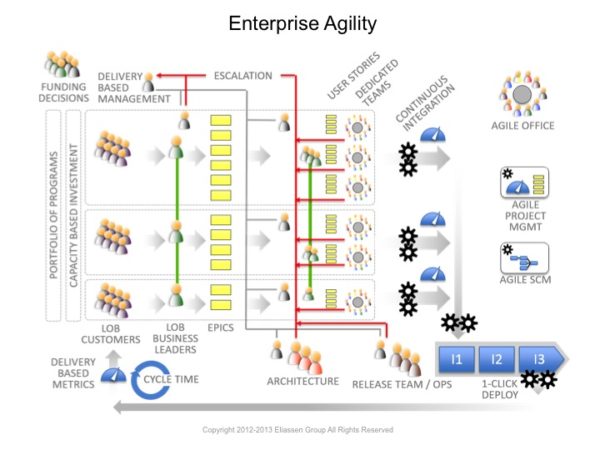This guest post from Damon Poole, Chief Agilist at the Eliassen Group, is the first in a Do Agile Right mini-series about about agile maturity. Damon’s 22 years of software experience spans from small co-located teams all the way up to global development organizations with hundreds of teams. Damon has spoken at numerous conferences including Atlassian Summit 2013.
Introducing the Enterprise Agility Maturity Matrix
It is hard to manage what you can’t measure. A common problem in Enterprise Transformations is that “Agile” often means something different to everyone involved. Without a clear understanding of the goal, it is hard to set direction, measure progress, or achieve success. Compounding this problem is the fact that “going Agile” is typically perceived as something that mostly just effects the Agile team members, not the whole ecosystem including the folks on the business/product management side.

The Enterprise Agility Maturity Matrix can be used to set transformation goals, monitor progress, and get everybody on the same page regarding Agile including: Agile Coaches, team members, managers, and senior leadership. This tool has also been used in many other creative ways, such as to focus retrospectives and to help people at all levels do a self assessment of their own understanding of Agile so as to encourage self-paced learning and open people up to learning from folks that may have more Agile experience.
The tool is a spreadsheet with a section for describing the organization as a whole and another section which is for describing individual teams. There are a number of Agile indicators for each section and each indicator ranges from a ‘0’ (impeded) to a ‘4’ (ideal). For each cell in the matrix, there is a simple English explanation of what it means to be at that level for that indicator. The goal is to get as many indicators to a ‘2’ (sustainable) as possible. This helps the organization understand when they are over the main hump of adoption so that they don’t stop investing in the adoption too early. If not enough indicators get to the sustainable level, the organization will likely backslide to its old ways.
This Enterprise Agility Maturity Matrix was initially developed by a large group of Eliassen Agile Coaches that have had experience with Enterprise Agile Transformations at a wide range of organizations. Over the past six months it has been more widely disseminated via seminars and webinars, and has been refined based on the input of people who have downloaded it and provided feedback. We are now making it even more widely available via this blog, and look forward to your feedback. We will continue to provide additional information on how to best use this tool in future blog postings.
Download the Enterprise Agility Maturity Matrix via dropbox: http://bit.ly/10hpvxb .
What’s next?
In this article (originally posted on the Eliassen Agile Blog), Damon introduced the Agile Maturity Matrix. In the next article we will focus on tracking agile maturity using Jira Agile, and assessing how agile your organization really is. Check out our website for more tips about doing agile right.